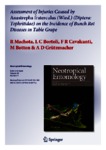Por favor, use este identificador para citar o enlazar este ítem:
http://www.alice.cnptia.embrapa.br/alice/handle/doc/1048775Registro completo de metadatos
| Campo DC | Valor | Lengua/Idioma |
|---|---|---|
| dc.contributor.author | MACHOTA JUNIOR, R. | pt_BR |
| dc.contributor.author | BORTOLI, L. C. | pt_BR |
| dc.contributor.author | CAVALCANTI, F. R. | pt_BR |
| dc.contributor.author | BOTTON, M. | pt_BR |
| dc.contributor.author | GRÜTZMACHER, A. D. | pt_BR |
| dc.date.accessioned | 2016-07-14T11:11:11Z | pt_BR |
| dc.date.available | 2016-07-14T11:11:11Z | pt_BR |
| dc.date.created | 2016-07-14 | pt_BR |
| dc.date.issued | 2016 | pt_BR |
| dc.identifier.citation | Neotropical Entomology, Londrina, PR, v. 45, n. 4, p. 361-368, 2016. | pt_BR |
| dc.identifier.uri | http://www.alice.cnptia.embrapa.br/alice/handle/doc/1048775 | pt_BR |
| dc.description | Resumo: Anastrepha fraterculus (. Wied) é a principal praga de uvas de mesa (Vitis vinifera) na Região Sul do Brasil. Neste estudo, o objetivo foi investigar o efeito da punção de frutas por fêmeas adultas e infestação larvária por A. fraterculus na ocorrência da doença podridões na uva (cultivar "Itália"). Abstract: Anastrepha fraterculus (Wied.) is the main insect pest of table grapes (Vitis vinifera) in the Southern Region of Brazil. In this study, we aimed to investigate the effect of fruit puncturing by adult females and larval infestation by A. fraterculus on the occurrence of bunch rot disease in the grape (cultivar ?Itália?) by evaluating grapes (a) punctured for oviposition by females of A. fraterculus, sterilized in laboratory with novaluron (40 mg L−1) and further spray-inoculated separately with Botrytis cinerea (1 × 106 conidia mL−1), Glomerella cingulata (1 × 106 conidia mL−1), and bacteria and yeast that cause sour rot (1 × 105 cells mL−1), (b) grapes punctured for oviposition by non-sterilized females with pathogen spraying, (c) grapes with mechanical wounds and pathogen spraying, (d) grapes with no wounds and with pathogen spraying, (e) grapes punctured for oviposition by A. fraterculus chemically sterilized in laboratory with novaluron, (f) grapes punctured for oviposition by A. fraterculus non-sterilized in laboratory with novaluron, (g) grapes with mechanical wounds, and (h) grapes with no sterilization or pathogen spraying. Our data indicated that the mechanical and oviposition wounds caused by A. fraterculus increased the percentage of grapes infected by B. cinerea, G. cingulata, and microorganisms of acid rot. The grape puncturing by A. fraterculus and the mechanical wound allows the penetration of B. cinerea and microorganisms leading to acid rot. We conclude that the fruit fly A. fraterculus may facilitate phytopathogens penetration leading to bunch rots in the table grape Itália. | pt_BR |
| dc.language.iso | eng | pt_BR |
| dc.rights | openAccess | eng |
| dc.subject | South American fruit fly | pt_BR |
| dc.subject | Fruit damage | pt_BR |
| dc.title | Assessment of Injuries Caused by Anastrepha fraterculus (Wied.) (Diptera: Tephritidae) on the Incidence of Bunch Rot Diseases in Table Grape. | pt_BR |
| dc.type | Artigo de periódico | pt_BR |
| dc.date.updated | 2019-05-07T11:11:11Z | pt_BR |
| dc.subject.thesagro | Mosca das frutas | pt_BR |
| dc.subject.thesagro | Mosca-sul-americana | pt_BR |
| dc.subject.thesagro | Mosca | pt_BR |
| dc.subject.thesagro | Anastrepha | pt_BR |
| dc.subject.thesagro | Praga | pt_BR |
| dc.subject.thesagro | Uva | pt_BR |
| dc.subject.thesagro | Botrytis Cinerea | pt_BR |
| dc.subject.nalthesaurus | Grapes | pt_BR |
| dc.description.notes | Disponível em:<http://link.springer.com/article/10.1007/s13744-016-0377-y> | pt_BR |
| riaa.ainfo.id | 1048775 | pt_BR |
| riaa.ainfo.lastupdate | 2019-05-07 -03:00:00 | pt_BR |
| dc.identifier.doi | 10.1007/s13744-016-0377-y | pt_BR |
| dc.contributor.institution | Depto de Fitossanidade, Univ Federal de Pelotas, Pelotas, RS, Brasil; Depto de Fitossanidade, Univ Federal de Pelotas, Pelotas, RS, Brasil; FABIO ROSSI CAVALCANTI, CNPUV; MARCOS BOTTON, CNPUV; Depto de Fitossanidade, Univ Federal de Pelotas, Pelotas, RS, Brasil. | pt_BR |
| Aparece en las colecciones: | Artigo em periódico indexado (CNPUV)  | |
Ficheros en este ítem:
| Fichero | Descripción | Tamaño | Formato | |
|---|---|---|---|---|
| 10.1007s137440160377y.pdf | 587,39 kB | Adobe PDF |  Visualizar/Abrir |









